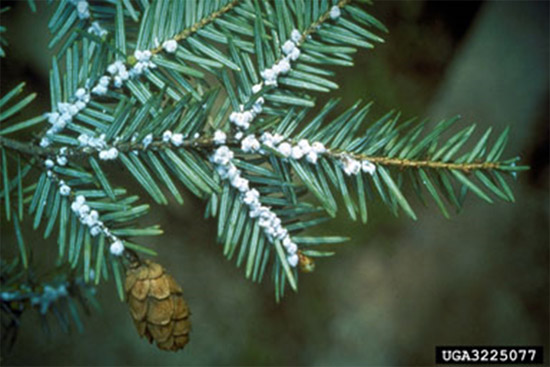Issue 8, June 14, 2013
Invasive Species Spotlight: Hemlock Woolly Adelgid
The hemlock woolly adelgid was first identified in 1924 in the Pacific Northwest and in the 1950’s in Richmond, Virginia. Infested areas of eastern and Carolina hemlocks in the eastern United States are increasing in number). To date, this invasive insect has not been found in Illinois. It was discovered in Indiana in 2012.
Although the natural growing range of hemlock trees is just to the east of Illinois, these plants are quite adapted to landscape use and are popular in many areas within the state. Hemlocks make interesting trees in the cultivated landscape. They provide year-round color and soft textures. These insects have spread rapidly through the Appalachians, mostly by wind or carried by migratory birds, mammals, and humans. However, infested nursery stock has also carried the insect into some areas. This is a concern within the state of Illinois.
Adelgids are mostly associated with coniferous trees. Hemlock is the primary host, with spruce being a possible secondary (alternative) host. The adelgid feeds on the sap of these trees, which can deplete its essential fluid and nutrient supplies, and produces saliva which contains toxins harmful to the trees.
These small aphid-like insects are less than 1/16 in long, black in color, and usually covered in a white puffy wax which progressively becomes thicker during their one year life cycle. The wax serves as a barrier to protect them from predators as well as to keep them from drying out during low humidity. They are usually found in great numbers almost covering entire sections of tree branches.

Hemlock woolly adelgid (photo courtesy of Connecticut Agricultural Experiment Station Archive, Connecticut Agricultural Experiment Station, Bugwood.org)
This particular species often undergoes a brief period of dormancy during the heat of the summer but can still be found on the stems of the plant. Adelgids, like many aphids, reproduce parthenogenetically, that is, the entire population is female and undergoes asexual reproduction. It can reproduce in large numbers very quickly. A typical adelgid can produce up to 300 eggs at a time and can reproduce twice in one year. While their populations increase on a tree growth becomes stunted, needles begin to fade and fall off the tree. Within a few years a highly infested tree will perish.
Because the hemlock woolly adelgid has no real natural predators in the eastern United States, its populations have grown rapidly allowing it to cause large amounts of damage to hemlock stands. Researchers are investigating the benefits and efficiency of introducing predatory insects into infested areas to serve as a control measure in large forested areas. Other treatments successfully used for individual trees include systemic insecticides, horticultural oils, and insecticidal soaps.
Informative Links on Hemlock Woolly Adelgid:
Bugwod Wiki
Forest Health Protection Program
Forest Service Pest Alert
USDA Species Profile
Save Our Hemlocks
Hemlock Woolly Adelgid Webinar from EAB University
If you suspect a hemlock wooly adelgid infestation, please contact Kelly Estes at the Illinois Cooperative Agricultural Pest Survey program at (217)333-1005 or kcook8@illinois.edu.